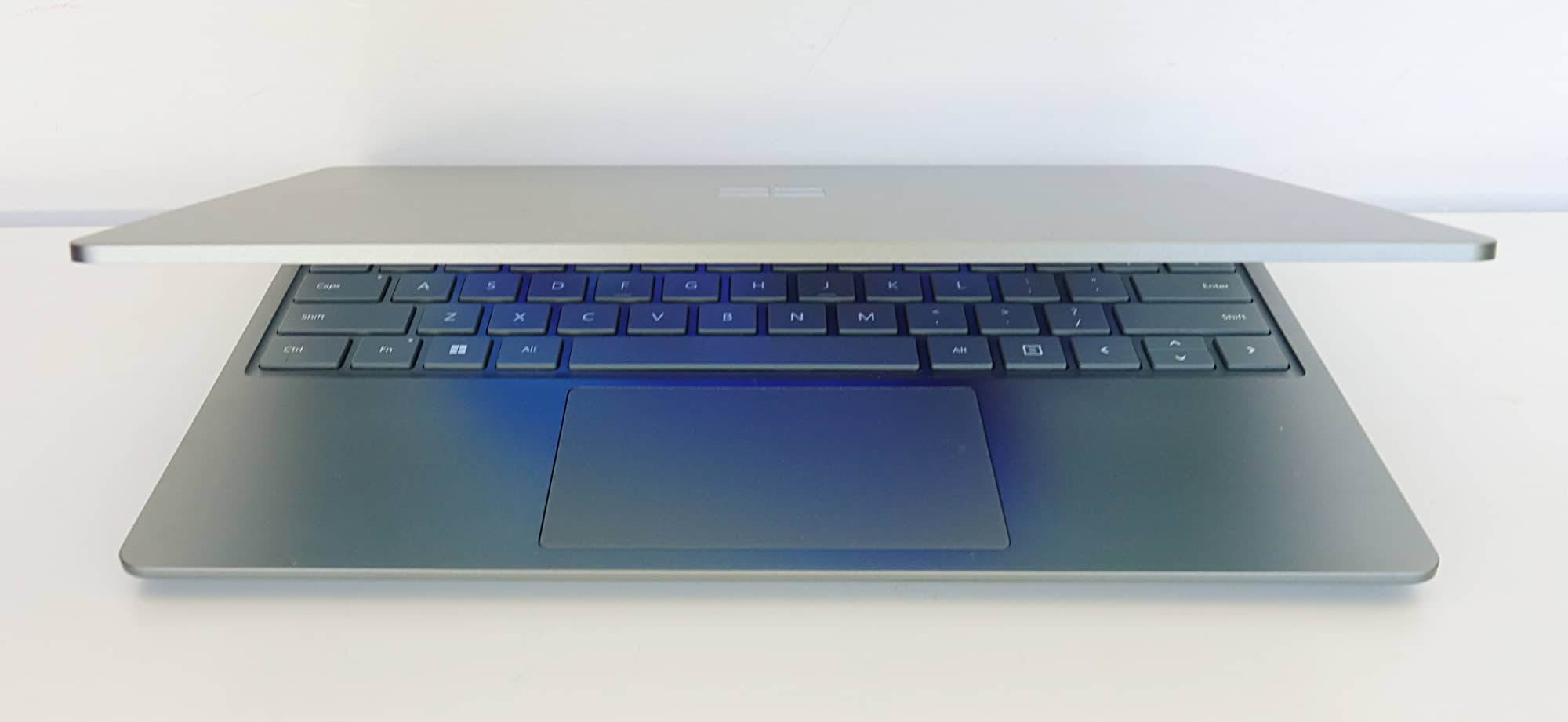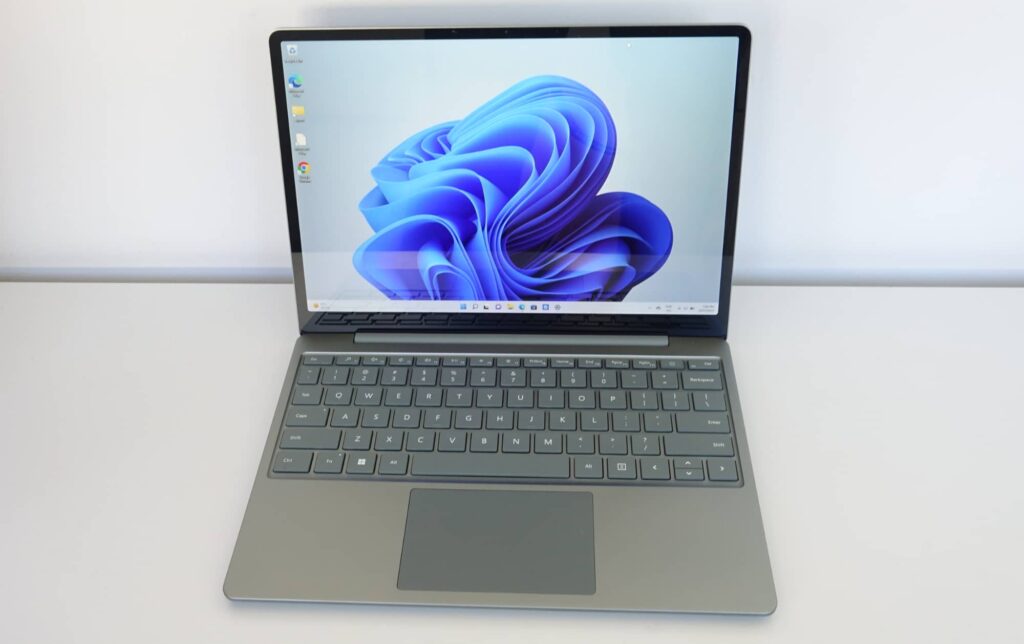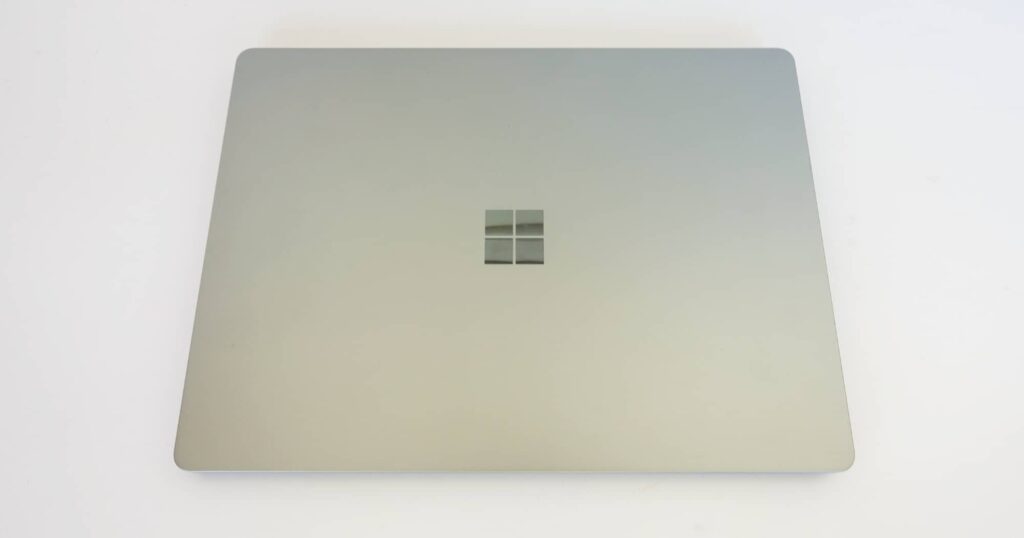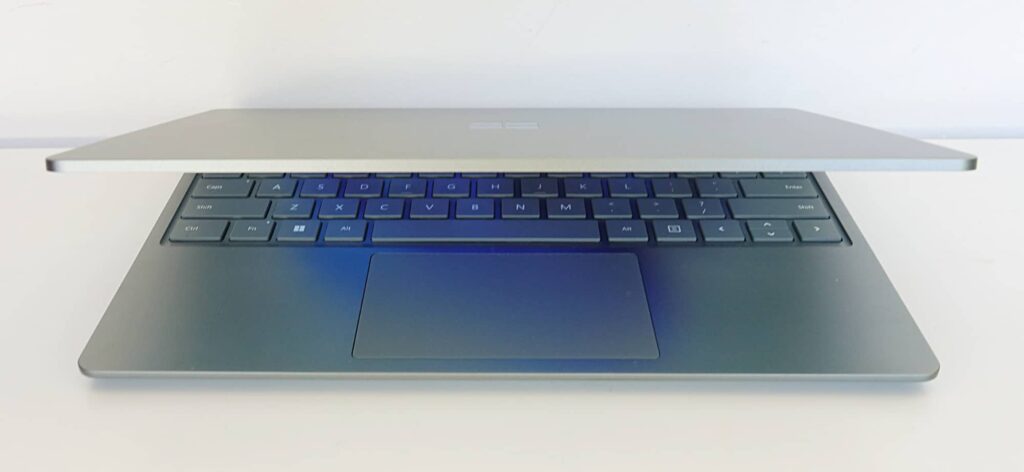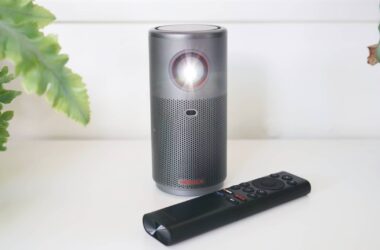Quick review
The good
The not-so-good
Microsoft’s latest take on a more portable laptop arrives in the Surface Laptop Go 2, but is it something made for big budgets or little ones with laps sized to match?
Design
With a design inspired by the lovely Surface Laptop, but just made to be a little more portable, it’s easy to see what Microsoft is trying for in the Surface Laptop Go 2.
Similar just smaller, the maker of Windows has gone with a combination of aluminium and plastic to take the place of aluminium entirely in the regular full Surface model, because full aluminium would clearly be too premium. Rather, you get aluminium on the top for the list and the keyboard tray, and a plastic or polycarbonate undercarriage, kind of completing it.
In short, the Surface Laptop Go 2 is premium-ish, but also not quite. It looks more premium than it feels, but that’s not necessarily a bad thing, because given how not every laptop has jumped onto the whole premium material bandwagon, it still gives the Surface Laptop Go 2 a feeling that puts it a cut ahead of many others.
You won’t see the fabric-lined arm rest used in the regular Surface Laptop line, mind you. This is a light metal you’ll be pressing your wrists to, and that’s not bad. As we said, it’s premium-ish, which is nice, but not necessarily the very best.
Features
“Premium-ish” is another way of explaining what’s inside, because unlike your typical mid-range machine, Microsoft has gone with a decent chip, albeit one that is a little bit older.
Inside, you’ll find an 11th-gen Intel Core i5 chip, the 1135G7, paired with either 4 or 8GB RAM, and a choice of storage, with the usual assortment of Bluetooth 5.1 and 802.11a/b/g/n/ac/ax WiFi. Yes, the Surface Laptop Go 2 supports WiFi 6.
There are wired connections on this computer, too, with one regular USB Type A port (the old rectangular port), one Surface connect port, and a lone Type C port that has become the EU standard, plus a 3.5mm headphone jack for audio out, as well.
There’s also a 720p HD camera built above the screen, which itself is a 12.4 inch touchscreen in a 3:2 aspect ratio, alongside two mics, two speakers, and a fingerprint sensor built into the power key on the keyboard section below.
The Surface Laptop Go 2 arrives in a combination of aluminium and polycarbonate, and also comes in several colours.
There are two major configuration options for the Surface Laptop Go 2, with the cheap model offering 4GB RAM and 128GB storage alongside all those specs, and then a model with 8GB and either 128GB or 256GB storage.
For this Surface Laptop Go 2 review, we used the Sage model with 8GB RAM and 256GB storage in the colour Sage, but which model you pick comes down to you and your needs. However, we’d caution anyone considering the 4GB model, as 4GB RAM is hardly enough for Windows to really feel useful beyond loading a handful of apps at any one time, and it can’t be upgraded later on.
Display
Once you decide on the memory and storage spec, you can get stuck into the whole machine, which has seen some changes, though not everywhere. While there’s a number in the name and the spec list has changed slightly, the display has not, as Microsoft leaves one of the most underwhelming features from the first model here in this model: the screen.
At 12.4 inches, Microsoft has the right idea for portability, getting something that isn’t quite as small as 11 inches, but also gets in under the 13 inch size that has become the very definition of portable in PCs. Great.
Unfortunately, the resolution is still really weak and too low overall. Marginally higher than 720p yet still under the Full HD 1080p you expect a screen to have these days, Microsoft’s Surface Laptop Go 2 screen still runs with the lowly resolution of 1536×1024, a low res that students would struggle to use Photoshop with, and that an iPad can easily best. The pixel clarity is piddling alongside, boasting a grand total of 148 pixels per inch.
To put that into perspective, the current entry-level iPad that retails from $499 in Australia has a screen resolution of 2160×1620 in a 10.2 inch size with a pixel clarity of 264 pixels per inch.
Yes, you read that right: the budget iPad has a better screen than the budget Surface.
It’s a poor effort, and not the sort of thing you expect from a computer retailing from twice that price, starting at $1099 locally. Granted, they’re totally different machines, an iPad and a Surface, with one being a full touchscreen tablet and the other being a computer with a touchscreen, but it’s not a great start when the weakest part of the first model has stuck around in the follow-up to that one. Yeesh.
In-use
At least the usability isn’t hampered using that meh screen, which is easy enough to use, though clearly not the best in class.
While we wish it had more pixels, it is at least a touchscreen, so you can push, prod, and touch it to make it do things, and is paired with a decent little trackpad beneath the space bar. The keys are quite comfortable, but can feel a little plasticky at times, offering a decent typing experience, though one that doesn’t feel quite as solid as Microsoft’s best.
And hey, there’s even a fingerprint sensor found in the design, with the power button just off from the side, flanked by the Page Down and Delete keys, helping to keep you from accidentally pressing it.
Performance
One area that doesn’t feel terribly bad is the performance, even if the chips are from last year.
Benchmark-wise, the Surface Laptop Go 2 doesn’t fare too differently from the Lenovo Yoga Slim 7i we checked out around the same time last year, and that should hardly be a surprise: it’s the same chip choice, but with Windows 11 running alongside.
That means provided you opt for the 8GB model, you should find the Laptop Go 2 handles most of what you throw its way, provided that low res screen doesn’t get in the way.
Our tests included a typical assortment of productivity apps, web browsing, and hey, installing Chrome instead of Microsoft Edge (it’s fine, really), and the chip and memory combination held up quite well for much of what we needed, with minimal lag and some admirable start-up times. There are a few bumps here and there, and an app might take a little longer to switch back on from standby or come back, but by and large, it’s an acceptable result all the same.
Weirdly, one of our favourite aspects in using the Surface Laptop Go 2 came from its version of Windows because finally, Microsoft has moved on from the "S" edition of Windows.
That is to say you get a full version of Windows 11 (Windows 11 Home) in the Laptop Go 2, and you can start installing all your favourite apps without being forced to use the Windows Marketplace, which is marginally better than what it used to be but still not great.
But hey, this is a full version of Windows, so let's forget about the past, the "what was" on the last Surface Laptop Go, and think of the now, which is much more enjoyable to use.
Battery
In most areas, anyway. Battery life isn't one of them.
While we're not sure whether Windows 11 is the reason the battery life doesn't quite kick the goal it should, the 13 hours quoted by Microsoft may not be helped by it.
Throughout our time reviewing the Surface Laptop Go 2, our battery life typically ran from 7 to 8 hours, which is roughly half of what is suggested.
That's fine for a day, but not super amazing, and suggests you'd need to be doing a whole heap of nothing for that 13 hours to be achievable.
Fortunately, a Type C port is included, and you can charge from it, making it fairly easy to grab a phone charger and boost it up, provided it's of a decent output. As it is, the Surface Laptop go 2 comes with a 39W adaptor, which is a little more than the 5 or 10W most phones come with, but if you have something meatier in your bag, maybe one of those dual port GaN bricks we keep with us, the laptop should charge up a little more quickly in a pinch.
Value
Even if the battery was better, though, we're not sure the Surface Laptop Go 2 is necessarily worth the price of admission.
We need to stress that this computer may feel like a premium design, but the heart is all budget and basic needs. That $1099 4GB RAM entry level really sends the message that budget computers are being catered for here, because no other computer gets 4GB unless it's made to be inexpensive.
Memory is where computer makers typically send that message, and it's being heard loud and clear. Go below 8GB and you typically know a laptop is going to be inexpensive, while go over it to 16GB and 32GB, and the laptop will be expensive.
In the Surface Laptop Go 2, Microsoft has sent a message that even with an 8GB model, the 4GB is for budget buyers, but at a little over a grand, that message is flawed.
Sure, the 8GB model isn't much over it, and that's the model you should definitely consider if you want the Surface Laptop Go 2 in your life -- either one, pick your colour or storage choices -- but even when you crank up the price slightly, the value is still a little awkward.
By comparison, the slightly bigger but better spec'd Surface Laptop 4 starts from barely a little more at $1348, and comes with 8GB RAM and 256GB storage by default. Frankly, the upsell to the better machine makes a lot more sense than the price the Surface Laptop Go 2 is positioned at.

What needs work?
The questionable value may come down to the things Microsoft hasn't brought up to spec with everything else you can find today. Namely, the screen isn't great, the chips are a little old, and the battery needs some more love.
The screen is the one we feel like we're banging on about. Oh sure, the 11th-gen Intel chips aren't significantly out of date, with 12th-gen popping up this year, but it's enough to let you know that you could find the newer chips in something else if you really wanted. And sure, the battery on any laptop could be better, though Apple getting out over 12 hours on the M1 Air is still impressive several years on, and there's a new model around the corner.
No, that screen is the thing that bugs us tremendously. While it's technically taller than most displays thanks to that unorthodox 3:2 aspect ratio, the low resolution may make apps a little flawed on them, and won't look as great to your eyes.
We expect lower resolution screens in properly budget laptops made for kids, but they tend to sit around the $400 to $700 mark. Hitting over a thousand for this just feels wrong, and in its second iteration, Microsoft should know better.
Final thoughts (TLDR)
Reviewing the Surface Laptop Go 2 is more difficult than we expected, because there are things you can fall in love with, and others that just make us grit our teeth and ask why.
Between the meh screen and odd pricing, there are definite reasons that give us pause. And yet, the design, size, and lovely keyboard are all great reasons to consider carrying a Surface Laptop Go 2 around with you.
Maybe it's a case of third time's the charm, because in version three, Microsoft may just nail it. Right now, we'd wait until the price fell just that little bit more. It might take a Black Friday or Prime Day to make the Surface Laptop Go 2 worth what you pay, but right now, it's barely more than a premium take on budget.



